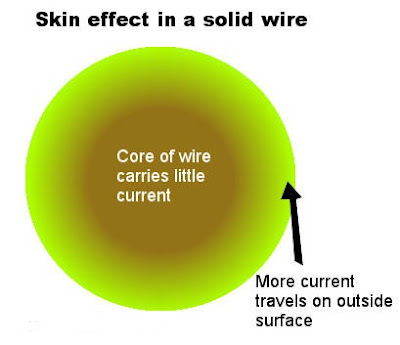Skin Effect
The alternating current flowing through the conductor is non-uniformly distributed throughout its length. This is because the outer strands of the conductor (i.e., the strands which form the surface of the conductor) carry more current than the inner strands (i.e., the strands which are closer to the center of the conductor). This non-uniform distribution of current causes an increase in the resistance of the conductor to the flow of alternating current. This effect is known as skin effect and it shown in figure.
 |
| Skin Effect in Transmission Lines |
This effect is termed because skin effect as the charges flow through the surface (skin) and not through the center of the conductor. The skin effect is absent when the current is DC this is because the direct current flowing through a conductor spreads uniformly throughout the cross—sectional area of the conductor.
Why Skin Effect Occurs in Transmission Lines ?
The main cause of skin effect is the non-uniformity of flux linkage. The phenomenon of skin effect can be explained as follows:
Consider a multi—stranded conductor composed of ‘n’ number of strand (filaments). The AC current flowing through the inner strands produce flux which links (enclose) the inner strands only. But, the flux produced by the flow of AC current through the outer strands, links (enclose) not only the outer strands but also the inner strands. Thus,,the flux linkage per ampere to the inner strands is higher than the flux linkage per ampere to the outer strands. This causes the inductance (and hence inductive reactances) of inner strands to be much higher than for the outer strands. Thus, higher the impedance lower » is the flow of current. As a result, the outer strands carry more current than the inner strands.
Factors Affecting Skin Effect in Transmission Lines
Skin effect primarily depends on the three important factors,
1. Operating frequencies
2. Size of conductor
3. Type of conductor.
Higher the operating frequency, the greater is the skin effect. The diameter of conductor has a direct relation with skin effect. Bigger the diameter of conductor, higher is the skin effect. The type of conductor also decides the level of skin effect. The skin effect is less incase of a stranded conductor than a solid conductor.
